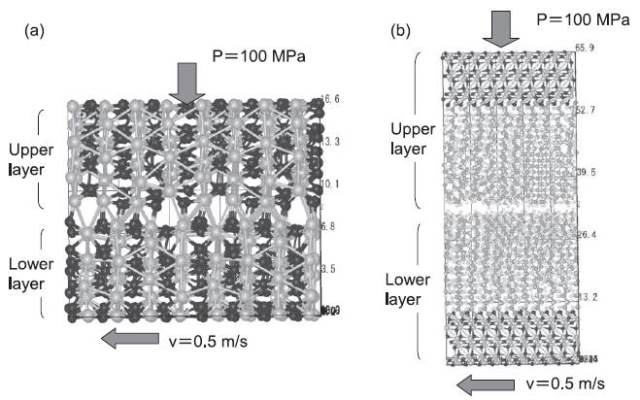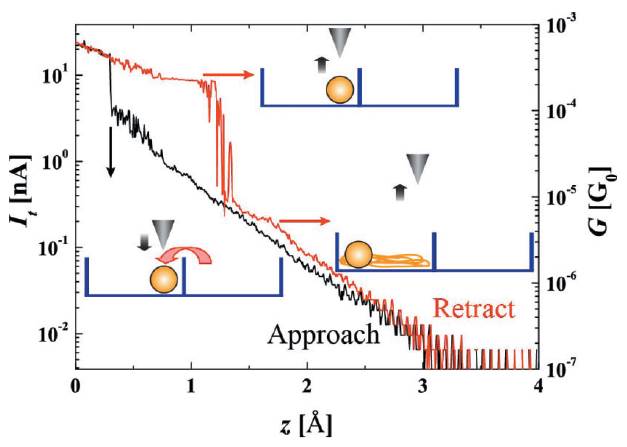All issues

Successor
Volume 36, Issue 5
Displaying 1-13 of 13 articles from this issue
- |<
- <
- 1
- >
- >|
Preface
-
Kouji MIURA2015Volume 36Issue 5 Pages 221
Published: May 10, 2015
Released on J-STAGE: May 26, 2015
JOURNAL FREE ACCESSDownload PDF (165K)
Special Issue: Energy Dissipation and Control of Friction
-
Hiroshi MATSUKAWA, Michio OTSUKI, Ken NAKANOArticle type: Review
2015Volume 36Issue 5 Pages 222-229
Published: May 10, 2015
Released on J-STAGE: May 26, 2015
JOURNAL FREE ACCESSIt is widely believed that Amontons’ law of friction holds well in various systems. Here we show based on a numerical calculation and analytical theory that Amontons’ law breaks in viscoelastic materials under certain condition due to the precursor slip prior to the bulk sliding. It is also shown that instead of Amontons’ law new friction law holds, which states that the static friction coefficient decreases as a power functionof load with the power −1/3. The new friction law is verified by the experiment employing polymethyl-methacrylate. The relation between the critical length of the precursor and the static friction coefficient predicted by numerical calculation and analytical theory is also verified. View full abstractDownload PDF (1721K)
View full abstractDownload PDF (1721K) -
Takehito SUZUKIArticle type: Current Topic
2015Volume 36Issue 5 Pages 230-235
Published: May 10, 2015
Released on J-STAGE: May 26, 2015
JOURNAL FREE ACCESSThe effect of the interaction among heat, fluid pressure and inelastic pore creation on dynamic earthquake slip process is investigated. The diversity of dynamic earthquake slip can be explained by the single framework in a unified way, which includes three nondimensional parameters. In particular, two of them are found to govern the system behavior without fluid flow. Two qualitatively different slip behaviors, acceleration and spontaneous slip cessation, have been found and the function determining which case appears is derived analytically. The constitutive relationship between the frictional stress and the slip is also obtained. The least energy required to arrest the slip is related to the minimum value of the inelastic porosity change for the spontaneous slip cessation case. View full abstractDownload PDF (571K)
View full abstractDownload PDF (571K) -
Kenji FUKUZAWA, Shintaro ITOH, Hedong ZHANGArticle type: Current Topic
2015Volume 36Issue 5 Pages 236-241
Published: May 10, 2015
Released on J-STAGE: May 26, 2015
JOURNAL FREE ACCESSA new measurement method for clarifying friction loss in boundary lubrication is introduced. Optical-fiber-based method, called fiber wobbling method, uses a ball-ended optical fiber as a sliding probe. A vibrating probe slides a thin liquid film and friction force is measured from the amplitude and phase change due to friction loss. The probe is soft in the lateral direction and rigid in the normal one, which can provide high sensitive friction force measurement with accurate gap control. This method revealed that friction of nanometer-thick liquid lubricant films showed dry-friction-like energy dissipation, where the friction force did not depend on the sliding velocity. The result suggested that the slip between the liquid and solid is important for clarifying the boundary lubrication phenomena. View full abstractDownload PDF (677K)
View full abstractDownload PDF (677K) -
Hitoshi WASHIZUArticle type: Current Topic
2015Volume 36Issue 5 Pages 242-246
Published: May 10, 2015
Released on J-STAGE: May 26, 2015
JOURNAL FREE ACCESSMolecular origin of friction is related to the dissipation of the molecular motion energy responses to the external field produced by the sliding motion. Molecular dynamics simulations are suitable method to describe the process. In this article we review a history of molecular dynamics simulation related to tribology and show the “tribo-molecular dynamics” established in 1990s. If the major energy dissipation mode is restricted to the molecular motion in the vicinity of the surface, it is boundary lubrication and fully described by the simulation. In usual case of hydrodynamic lubrication or solid lubrication, however, molecular simulation can not describe the full process due to the large correlation length or low frequency vibration of the system. The understanding of the restriction is important in practical use of the method. View full abstractDownload PDF (577K)
View full abstractDownload PDF (577K) -
Yoshiaki SUGIMOTO, Masayuki ABE, Seizo MORITAArticle type: Current Topic
2015Volume 36Issue 5 Pages 247-252
Published: May 10, 2015
Released on J-STAGE: May 26, 2015
JOURNAL FREE ACCESSSupported nanoclusters have attracted considerable attention in recent years, by virtue mainly of their unique size-dependent properties. Various novel approaches have been developed to create nano-clusters with different functionalities on surfaces. In this study, we propose an alternative approach to the assembly of various nano-clusters atom-by-atom using the tip of a scanning probe microscope (SPM) at room temperature. Half-unit cells of the Si(111) - (7×7) surface serve as nanospace (NS) arrays to confine individual adsorbates diffusing on the surface. This method is based on the transfer of single diffusing atoms among NSs by the chemical interaction force with the SPM tip. The clusters with predetermined compositions, such as Au12, Ag12, and Au5Pb, can be formed by collecting single atoms from the surrounding NSs into a pre-defined NS with successive atom manipulations. View full abstractDownload PDF (1647K)
View full abstractDownload PDF (1647K) -
Makoto ISHIKAWA, Naruo SASAKI, Kouji MIURAArticle type: Current Topic
2015Volume 36Issue 5 Pages 253-256
Published: May 10, 2015
Released on J-STAGE: May 26, 2015
JOURNAL FREE ACCESSExfoliation and adhesion are a daily ordinary phenomenon. However, these exhibit irregular behaviors on the atomic-and molecular-scale. In this article, we introduce that a carbon nanotube exhibits atomic-scale movements on a graphite substrate, in which stick-slip sliding occurs at the atomic scale while maintaining AB-stacking registry with the graphite substrate. It is expected that the study on exfoliation and adhesion provides control of friction, a stronger adhesion and an easier exfoliation than those of a gecko foot and applications for nanomachine and biomolecular motor. View full abstractDownload PDF (844K)
View full abstractDownload PDF (844K)
Original
-
Hiroshi KUWAHATA, Takeshi YAMAGUCHI, Hisao KOJIMA, Kazuya KABAYAMAArticle type: Original
2015Volume 36Issue 5 Pages 257-262
Published: May 10, 2015
Released on J-STAGE: May 26, 2015
JOURNAL FREE ACCESSThe aim of this study was to determine the effect of plasma irradiation, which is used in plasma medicine on biological tissues (cells). We used phospholipids, the main components of the cell membrane, namely, phosphatidylcholine (PC), phosphatidylglycerol (PG), and phosphatidylethanolamine (PE). Reference samples of the three phospholipids were irradiated with an atmospheric-pressure argon (Ar) plasma jet for 5s. The phospholipids irradiated with a plasma jet were separated by thin-layer chromatography (TLC). The TLC results indicated that several degradation products were obtained for PC and PG but not for PE after plasma jet irradiation. One of the degradation products obtained from PC was identified as lysophosphatidylcholine (LPC) and one of the products obtained from PG was identified as lysophosphatidylglycerol (LPG) by liquid chromatography-mass spectrometry. Therefore, PC and PG are degraded into their respective lysophospholipids by plasma jet irradiation, which disrupts the cell membrane. View full abstractDownload PDF (765K)
View full abstractDownload PDF (765K)
Planning Series
Surface Science for Environmental Issues
-
Yukihiro CHIBA2015Volume 36Issue 5 Pages 263-264
Published: May 10, 2015
Released on J-STAGE: May 26, 2015
JOURNAL FREE ACCESS
Science Café
Research Abroad
-
Fumihiko MATSUI2015Volume 36Issue 5 Pages 265-266
Published: May 10, 2015
Released on J-STAGE: May 26, 2015
JOURNAL FREE ACCESSDownload PDF (650K)
News from Branches
-
Kenji MURAKAMI2015Volume 36Issue 5 Pages 267
Published: May 10, 2015
Released on J-STAGE: May 26, 2015
JOURNAL FREE ACCESSDownload PDF (154K)
Qualifying Examination for Surface Science Engineers
-
2015Volume 36Issue 5 Pages 268
Published: May 10, 2015
Released on J-STAGE: May 26, 2015
JOURNAL FREE ACCESSDownload PDF (1123K)
News & Trends
-
2015Volume 36Issue 5 Pages 269
Published: May 10, 2015
Released on J-STAGE: May 26, 2015
JOURNAL FREE ACCESSDownload PDF (170K)
- |<
- <
- 1
- >
- >|
